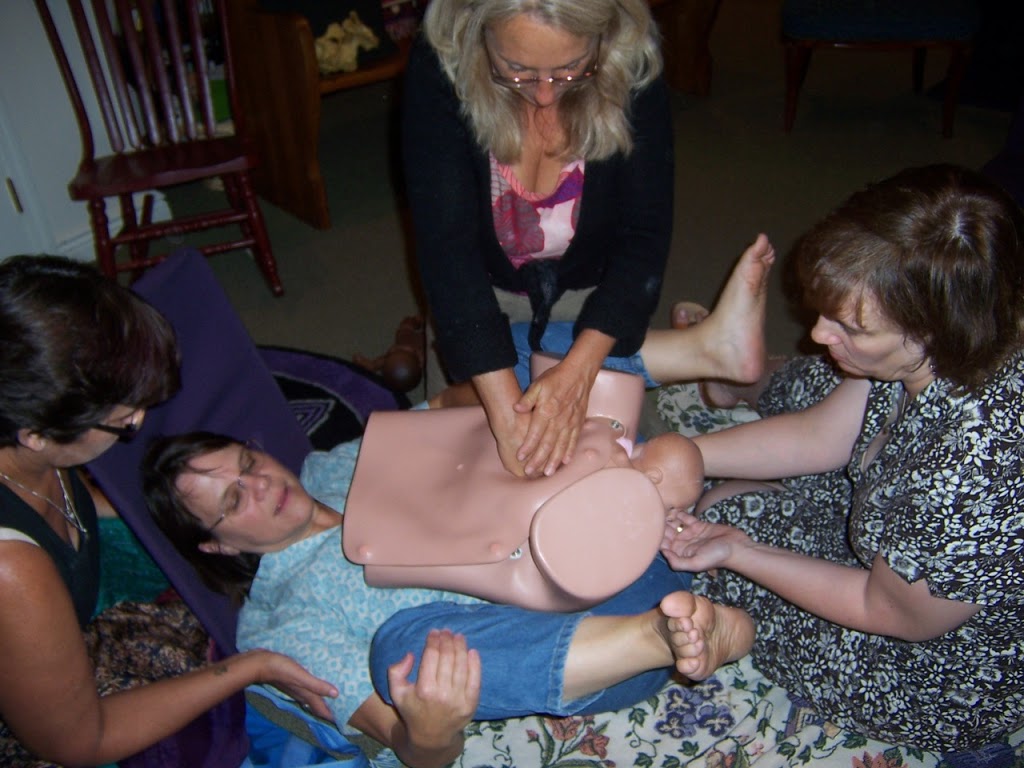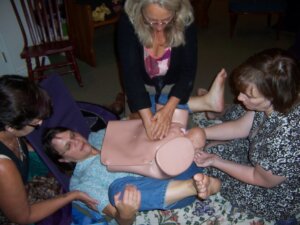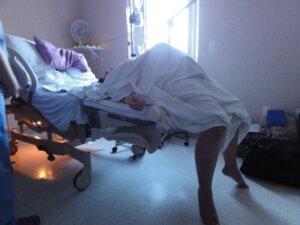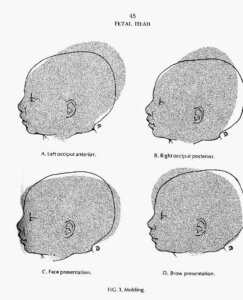
I enjoyed reading David Desseauve’s French review on positions for labor and birth. I especially enjoyed finding a tip included from Aspasia, a midwife/gynecologist from the second century (translated from the ancient Greek by Pascal Luccioni),
If the difficulty comes from the curvature of the lumbar region … put the parturient in a position with her knees flexed so that, with the vulva situated at the top, the pathways are easier.
Aspasia was noting the position of the legs, thighs and curvature of the lumbar spine and how this position affected the physics of birthing by letting the baby find room to descend. This is a description of a position now known as McRobert’s, named for a Texas Obstetrician who popularized the position for releasing delayed shoulders after the birth of the baby’s head.
McRoberts may not have known
Whence his popular technique had grown,
When it came to Physician Aspasia
He simply had position aphasia
And made all the credit his own.
Dr. McRoberts certainly may not have claimed any such credit; but this is a limerick and limericks are supposed to be naughty. Admittedly, literary liberties are no excuse for rudeness and I apologize for coarse poetry.
See a bas relief sculpture, an embroidery and description of Aspasia.
A history of birth positions was collected by several trying to change the practice of arranging women on their backs for birthing. Engelmann may be the most famous, or possibly Caldeyro-Barcia, in their campaigns to bring upright birthing positions to the attention of institutionally-oriented physicians.
The specific relationship of the legs to the pelvis are explored in modern day by body-movement expert Blandine Calais Germain in The Female Pelvis.
Two positions illustrate the relationship of the spine to the pelvis and affect the inlet. These are McRobert’s position with flexed knees and flattened lumbar, and Walcher’s position with legs extended and hanging off the bed from the low level of the trochanters of the femurs.
 |
| McRoberts doesn’t open the pelvis wider, but does change angle. |
In spite of Aspasia’s and other providers success with McRobert’s, MRI found the effect is not to open the pelvis. The success is rather to move the symphysis pubis towards the mother’s head while flattening the sacrum. This changes the angle of the inlet and sometimes allows the baby to come free of the inlet when stuck there — say when pushing and baby remains high. Clinical care providers (such as nurses) seek maternal positions to avoid cesarean surgery in long second stages and often rediscover this position because it is an easy adaptation of lithotomy (on the back). This is the position I think Aspasia was discussing in her quote.
 |
| Walcher’s position is tough but effective, and deserves eye-to-eye contact and support. |
 |
| Walter’s adapted for use with epidural or with a high BMI. |
Walcher’s was more recently dehttps://www.spinningbabies.com/wp-content/uploads/2019/10/sample3-1.pngd about 130 years ago in Germany. This position of extended legs does open the inlet approximately 1 cm, which is significant in childbirth. The position is more difficult to set up and may even be painful, but is quite effective within three contractions. Walcher’s is used when the baby remains high in 2nd stage or late active labor. I would suggest abdominal lift and tuck be done first if the birthing person can be standing. Walcher’s is appropriate for epidural with the adaption of having the foot of the hospital bed lowered. See above photo.
Desseauve and associates give a smart article on birth positions giving the state of knowledge and biomechanics perspectives. This short discussion praises a long-awaited, intelligent review that has been missing overall in the flutter of articles on hands-and-knees birthing positions.
While Desseauve et al. doesn’t claim to hold the answers, they are awakening the birth providers to the lack of answers currently in the medical literature. They suggest a system of classifying or characterizing positions of the spine, thighs and pelvis to better understand their differences in birth outcomes.
And they call for new methodological solutions to improve measurements of contraction force and properties of soft tissues, which are changed by the passage of the baby during birth.
 |
| Molding is caused by overlapping cranial plates. Shape of molding reflects the angle that baby’s head was in the pelvis during the time in labor baby molded. |
It was interesting for me to note Desseave’s adherence to the interest of force. I recently heard Bruce Lipton compare the shortcoming of Darwin’s perspective of survival of the fittest as being racist, classist and capitalist, whereas Wallace’s explanation, while sounding cold-hearted when you first hear the phrase “elimination of the weakest,” goes on to explain the role of cooperation for survival. Lipton lectures with a unique blend of science, social science and spirituality, which I’m not qualified to assess. But I do like his sound bite that cooperation is the key to survival. If you want to see a description of Bruce Lipton’s book, click here.
Force in contractions, and force of the baby against the soft tissues, including the cervix, pelvic floor and perineum was listed as the necessary for birth. Force was not well compared when pelvic diameters were opened or constricted because the medical literature isn’t on to how which diameters are opened yet. But forces on the pelvic floor in upright birth positions were studied and found much increased over lying in bed in Ashton-Miller et al’s contribution.
Aran’s 2012 study was cited in this article noting that the pelvic floors of women requiring a cesarean finish to labor had “higher pelvic tone.”
Higher pelvic tone is not always good. It can also be an unfortunate result from self-protective clenching, an instinct activated from an acute or chronic (or both) onslaught of emotional and/or sexual attacks or threats. Undoing the physical effect of the forces frozen in the pelvic floor can be temporarily achieved with the neurophysiological techniques of static stretch and jiggling (vibration which acts as tiny, repeated static stretches). Longer benefits can be achieved by repeating and increasing the range of myofascial restoration of balance.
What if we looked at effectiveness of contractions on cervical dilation, baby’s rotation, passage through the pelvic floor and supporting the intact status of the perineum as a cooperative dance in the body? What if we saw the mother and baby moving together for the purpose of birth? We would put off course of this supposed race of survival between parent and child. Phillip Steer catalyzed the current cesarean epidemic by claiming a Darwinist competition between increasing brain capacity of the baby (born with the intelligence to go on and develop cesarean section and so evident of successful evolution) with the reduced diameters needed for the mother to walk on two legs by which editorial proposition.
Techniques such as Forward-Leaning Inversion and Sidelying Release can often redirect the mother-baby dyad away from the operating room to the sudden release of birth.
Furthermore, when we begin a simple matching game to open the pelvis where baby waits, our fear of death under evolutionary competition will diminish. We will be able to stand beside women, sit beneath women, observe the movement of instinct and rejoice in birth again.
While it may not be the same Wallace, we might then join the Scots in praise,
A light arises, a light whose brightness shines clear…
Birth position and instinctual birth are closely related. Observation is crucial to learning but is not enough. I agree with Desseauve and colleagues, assessment of various positions will help understanding. Such understanding may help reduce obstructions to birth in the pelvis — our mistaken passivity or outright wrong recommendations for maternal positions in labors that seek our support.
Let’s conclude with the enthusiastic call to action of this research team:
Well-being during delivery presumes aiming toward a birth as physiological as possible. The role of the professional is thus to optimize this difficult event by increasing the woman’s efficiency while diminishing her exertion, fatigue, and perceived pain, and simultaneously ensuring the primary objective: the well-being of mother and child. This probably requires scientifically validated support and a return to a purely fundamental and modern approach through the resources available in biomechanic laboratories.”